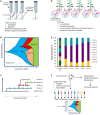Experimental Evolution in Plant-Microbe Systems: A Tool for Deciphering the Functioning and Evolution of Plant-Associated Microbial Communities
- PMID: 34025595
- PMCID: PMC8137971
- DOI: 10.3389/fmicb.2021.619122
Experimental Evolution in Plant-Microbe Systems: A Tool for Deciphering the Functioning and Evolution of Plant-Associated Microbial Communities
Abstract
In natural environments, microbial communities must constantly adapt to stressful environmental conditions. The genetic and phenotypic mechanisms underlying the adaptive response of microbial communities to new (and often complex) environments can be tackled with a combination of experimental evolution and next generation sequencing. This combination allows to analyse the real-time evolution of microbial populations in response to imposed environmental factors or during the interaction with a host, by screening for phenotypic and genotypic changes over a multitude of identical experimental cycles. Experimental evolution (EE) coupled with comparative genomics has indeed facilitated the monitoring of bacterial genetic evolution and the understanding of adaptive evolution processes. Basically, EE studies had long been done on single strains, allowing to reveal the dynamics and genetic targets of natural selection and to uncover the correlation between genetic and phenotypic adaptive changes. However, species are always evolving in relation with other species and have to adapt not only to the environment itself but also to the biotic environment dynamically shaped by the other species. Nowadays, there is a growing interest to apply EE on microbial communities evolving under natural environments. In this paper, we provide a non-exhaustive review of microbial EE studies done with systems of increasing complexity (from single species, to synthetic communities and natural communities) and with a particular focus on studies between plants and plant-associated microorganisms. We highlight some of the mechanisms controlling the functioning of microbial species and their adaptive responses to environment changes and emphasize the importance of considering bacterial communities and complex environments in EE studies.
Keywords: evolutionary adaptation; experimental evolution; holobiont; interaction network; microbiota; synthetic community.
Copyright © 2021 Manriquez, Muller and Prigent-Combaret.
Conflict of interest statement
The authors declare that the research was conducted in the absence of any commercial or financial relationships that could be construed as a potential conflict of interest.
Figures


Similar articles
-
Microbial Hub Taxa Link Host and Abiotic Factors to Plant Microbiome Variation.PLoS Biol. 2016 Jan 20;14(1):e1002352. doi: 10.1371/journal.pbio.1002352. eCollection 2016 Jan. PLoS Biol. 2016. PMID: 26788878 Free PMC article.
-
Lateral Gene Transfer in a Heavy Metal-Contaminated-Groundwater Microbial Community.mBio. 2016 Apr 5;7(2):e02234-15. doi: 10.1128/mBio.02234-15. mBio. 2016. PMID: 27048805 Free PMC article.
-
Adaptive evolution in ecological communities.PLoS Biol. 2012;10(5):e1001332. doi: 10.1371/journal.pbio.1001332. Epub 2012 May 15. PLoS Biol. 2012. PMID: 22615542 Free PMC article.
-
Experimental Evolution as a Tool to Investigate Natural Processes and Molecular Functions.Trends Microbiol. 2019 Jul;27(7):623-634. doi: 10.1016/j.tim.2019.02.003. Epub 2019 Mar 23. Trends Microbiol. 2019. PMID: 30910518 Review.
-
Ecology and potential functions of plant-associated microbial communities in cold environments.FEMS Microbiol Ecol. 2022 Jan 19;98(1):fiab161. doi: 10.1093/femsec/fiab161. FEMS Microbiol Ecol. 2022. PMID: 34910139 Free PMC article. Review.
Cited by
-
Novel Virus Identification through Metagenomics: A Systematic Review.Life (Basel). 2022 Dec 7;12(12):2048. doi: 10.3390/life12122048. Life (Basel). 2022. PMID: 36556413 Free PMC article. Review.
-
Pathogen Biocontrol Using Plant Growth-Promoting Bacteria (PGPR): Role of Bacterial Diversity.Microorganisms. 2021 Sep 18;9(9):1988. doi: 10.3390/microorganisms9091988. Microorganisms. 2021. PMID: 34576883 Free PMC article. Review.
-
Evolution of manipulative microbial behaviors in the rhizosphere.Evol Appl. 2022 Jan 14;15(10):1521-1536. doi: 10.1111/eva.13333. eCollection 2022 Oct. Evol Appl. 2022. PMID: 36330300 Free PMC article. Review.
-
Evolving a plant-beneficial bacterium in soil vs. nutrient-rich liquid culture has contrasting effects on in-soil fitness.Appl Environ Microbiol. 2025 Apr 23;91(4):e0208524. doi: 10.1128/aem.02085-24. Epub 2025 Mar 11. Appl Environ Microbiol. 2025. PMID: 40067020 Free PMC article.
-
Experimental evolution of plant rhizobacteria reveals emerging adaptive mutations.mBio. 2025 Aug 13;16(8):e0102325. doi: 10.1128/mbio.01023-25. Epub 2025 Jul 14. mBio. 2025. PMID: 40657900 Free PMC article.
References
Publication types
LinkOut - more resources
Full Text Sources
Other Literature Sources

